Comparative Analysis of P2P Architectures for Energy Trading and Sharing
Abstract
:1. Introduction
- Performance analysis of the structured and unstructured P2P architectural models for P2P-ETS. A structured and unstructured P2P model has not been studied before for P2P-ETS aside from [9], which presented a general overview of the P2P model for power networks.
- Specific protocols such as Kademlia and Gia have improved performance than other protocols [24], and are therefore studied. A comparative analysis is used to determine their suitability for P2P-ETS networks in various transactive use-cases.
- The selected protocols are compared using the performance metrics of the communication requirements for DER/MG applications. No previous work compared the performance of the selected structured (Kademlia) and unstructured (Gia) P2P protocols for energy networks, specifically in ETS.
2. Related Work
3. Micro-Grid Applications
- Smart metering: The metering hardware is located at the Customer Premises Network (CPN) and used to measure and record customer energy consumption. The measured quantities are sent either on-demand or periodically to the utility grid for billing purposes and grid management. It is also used to measure power flow from DERs, MGs and storage systems [40,41].
- Home Energy Management System (HEMS): This consists of smart meters and customer appliances that monitor and control home devices to optimize local power production, consumption or storage. It manages energy generation devices, energy storage and energy consumption for the household in order to optimize energy efficiency.
- Demand Response (DR): It operates within the CPN to interact with the service providers. DR is used to manage the energy delivered to consumers. It is designed to influence the energy consumption patterns of a customer by offering a range of programs including dynamic pricing. DR programs could also be incentive-based, direct load curtailment (e.g., direct load control), demand bidding and buyback, and emergency demand reduction or price-based programs. Examples of price based DR programs include Time-of-Use (TOU), Critical Peak Pricing (CPP), Real-Time Pricing (RTP) and Inclining Block Rate (IBR) [40,42].
- Electric Vehicle (EV) charging: This has the capability for storage using its rechargeable battery pack to operate the vehicle’s electric motors. EVs are also examples of distributed storage systems that supply the customer premises grid with power through their charged batteries. EVs interact with the grid in two modes: Vehicle–to-Grid (V2G), and Grid-to-Vehicle (G2V). Depleted batteries of the EVs are charged in G2V mode, and the EVs supply energy to the grid through its charged batteries in V2G mode [43,44]. The charging time is one of the major issues with EV charging, as well as the deterioration of battery life with the number of charging cycles [45]. Thus, research [45] suggests that charging the EV battery with constant current and voltage could reduce the EV charging time by 16% and extend battery life by 10%.
- DER and Storage: DER from renewable sources can be located at the customer premises as well as at the utility network. These sources complement energy generation from the power grid by smoothing out power fluctuations. The storage system is required to retain excess generated energy in the event of surplus, and in order to power the connected loads in the event of deficit. Also, energy storage systems can be used to increase system reliability.
- Asset Management: This is an application designed to ensure quality of service for customers at a minimum cost. It offers integrated management, optimization of the work order process, automation and scheduling processes. Some of the key indicators that can be balanced by asset management includes the assets, system performance, maintenance cost, failure risks and reliability through the use of a communication infrastructure [44].
- Meter Data Management: Increase in metering data due to the two-way communication between the customer premises and the utility company, which makes meter data management a critical application to consider. Meter data management system has the responsibility to collect, store, analyze and process the data for appropriate pricing/billing, demand response, better customer experience and energy consumption management services. Meter data management systems have the capability to manage other meter types including electric, heat, and gas, by turning it on and off and transmitting data when appropriate [44].
Micro-grid Communication Requirements
- Latency: This is a measure of time delay interval between transmission and delivery of a message and is designed in seconds. Latency requirements imply the acceptable window of delay associated with data flow from a sending peer to a receiving peer for each energy network application [40]. Latency is a critical factor to consider while designing a communication architecture. Moreover, in energy network applications, energy information exchanges between subsystems have tight deadlines and thus require prompt transmission. Therefore, a communication network for transferring energy related messages should aim to meet latency requirements.
- Reliability: This is important to ascertain prompt energy distribution and to ensure that energy will be made available when it is required. Therefore, the communication network must ensure that a message will reach its recipient or target peer as intended and without losses. In P2P-ETS networks, unreliable communication among peers can be caused by a number of factors including link/node failure, routing inefficiency, high churn rate of peers, inadequate communication infrastructure, etc. All these possible causes should be considered in selecting or designing a communication architecture for energy networks. In addition, different applications require different levels of reliability, thus communication systems should provide flexibility in the choice of reliability based on the application.
- Throughput: It is a measure of the amount of data that can pass through a communication channel continuously, which is expressed in bits per seconds. With the increase in the amount of data generated from energy network applications, the choice of P2P communication architectures should be able to accommodate these increasing bandwidth applications to ensure low transmission delays, reduce packet losses and ensure prompt peer discovery and message delivery.
- Security: A secured communication system is needed to ensure that the P2P-ETS network is only accessible to authorized personnel, system data is not compromised and that it is always available when needed. As a MG is a critical infrastructure requiring stringent resilience to cyber-attacks, prosumers’ data privacy is to be ensured at all times. Thus, communication systems must provide assurance that energy assets and the P2P-ETS network are protected from cyber-attacks, customers’ data are protected from unauthorised access and that the communication system is robust against network attacks.
4. Peer-to-Peer Architectures for MGs
4.1. Structured Model
4.2. Unstructured Model
5. Simulation Model
6. Result Analysis and Discussion
6.1. Peers Discovery/ Lookup Mechanism:
- Hop Count/Latency: This is delay estimates or hop-count of the number of peers traversed to discover a peer in the network. To discover peers in structured overlays, a specific graph structure messages are used where represents the number of peers in the overlay network. In addition, to discover peers in unstructured network, Gia uses one hop replication approach, where each peer maintains a key list of its neighbors. Thus, a peer that receives a lookup query can actively respond by giving matches to the request. Figure 3 shows the average hop count for both (Kademlia and Gia) protocols. From the results, we observed that the average hop count for Gia is 0 for 100 peers and 1 for 1000 peers. However, with Kademlia, average hop count for 100 peers is 2, while for 1000 peers it is 3. This implies that unstructured protocols can discover a resource faster using fewer peers than structured protocols.
- Network bandwidth: This is the bandwidth overhead used to maintain the network, locate peers and route information to peers. As we showed in Table 2, the throughput requirements for energy networks vary per application, with most in the range of 9.6 to 56 kbps. The total network bandwidth comprises of individual peer bandwidth cost and network maintenance bandwidth cost. In Figure 4, it can be observed that Kademlia consumes higher total network bandwidth compared to Gia. This is because of the structured nature of Kademlia. Kademlia uses excess bandwidth to maintain the network, see Figure 5, which results in higher bandwidth cost as the network grows. On the other hand, Gia uses biased random walk for query search, resulting in less total network bandwidth utilization because no additional overhead is required to maintain the network. Specifically, to further analyze the performances of the two protocols with increasing number of peers in terms of the number of events and messages created, the protocols were observed at different time stamp. An instance of 1200 s, 2400 s and 3600 s were observed with varying number of prosumers from 25 to 1000. it was observed that the total number of messages, see Figure 6, and events, see Figure 7, created are more for Kademlia (thus consuming more bandwdith) than Gia; this is because Gia uses high capacity peers to direct searches in a growing network.
- Reliability: For energy networks, reliability is a function of efficient information routing among peers and efficient energy delivery. It is affected by number of dropped messages in the network. Communication architecture for energy network applications requires high reliability (for example, >99%). From Figure 8, the number of dropped bytes in Kademlia in peer lookup is approximately 0, thus satisfying the reliability requirement of MG as tabulated in Table 2. This implies that a structured network ensures that it locates any requested peers in the network at the cost of higher latency. In energy transaction, this suggests the ability of a Kademlia-supported network to ensure full peer energy price history/presence ensuring no waste of money by transacting peers. Conversely, an unstructured protocol uses best efforts to locate a peer and deliver a message. However, once a peer cannot be located, the message is dropped as seen in Figure 8. Also, it was observed that increasing the number of peers in the network does not affect the performance of Kademlia P2P protocol. However, increasing the number of peers in the unstructured network (using Gia) initially increases the drop rate of messages, but decreases as the activity period increases. Interestingly, after an activity period of 2400 s, it can be observed that with 100 peers in an unstructured network, the number of dropped messages started to increase. This is due to the churn rate of peers, which implies that messages are not being delivered because the peers have left the network or are not active.
6.2. Message Delivery/Message Routing
- Latency: Communication requirements for an energy network have tight delay requirements with most applications ranging from 300 ms to <1 min (see Table 2). From Figure 10, with 100 peers, Gia latency increases as the activity period increases, but with 1000 peers, the latency drops to 0.1 s over the activity period. Gia uses high capacity peers to route traffic in the network; this property is well suited for greater numbers of peers as is the case for 1000 peers as reflected in the results. However, with Kademlia, because of the structured approach to routing in the network, the latency remains below 0.5 s for both 100 and 1000 peers and decreases as the activity period increases. Thus, Kademlia would deliver messages across an energy network more rapidly than the unstructured Gia protocol. It was also observed that both protocols latency in message delivery is below 2 s, which is within the acceptable range of MG energy applications.
- Peers’ bandwidth overhead: This is the bandwidth overhead used by a specific peer in the network to deliver a message. It includes the peer-generated traffic such as query requests and replies. Figure 9 shows the bandwidth cost for incoming query messages received by each peer in the network. Figure 10 shows the bandwidth overhead for sending out replies to other peers in the network. Over the activity period, peers implementing Gia protocol has the higher individual bandwidth cost compared to peers implementing Kademlia protocol. The bandwidth cost of Gia fluctuates over the activity period as a result of peers joining and leaving the network. The average bandwidth overhead for each peer in Gia protocol is 20 bytes/s for an instance of 1000 peers and an average of 15 bytes/s for an instance with 100 peers. However, structured protocols have small demands on individual overhead. Kademlia has overhead cost of about 2 bytes/s for both 100 and 1000 peers. The structured approach to message delivery does not flood the peers with excessive overhead, thus saving a significant amount of peers’ bandwidth overhead.
- Reliability: Efficient communication between energy subsystems require high reliability of ≥98% (see Table 2) for prompt dissemination of messages. To analyze the performances of the two protocols with increasing number of peers in terms communication reliability, the protocols were observed at different time stamp. An instance of 1200 s, 2400 s and 3600 s were observed with varying number of prosumers from 25 to 1000. Message delivery ratio for Kademlia as seen in Figure 11 is an average of 99.96%, thus agreeing with the MG requirements listed in Table 2. This reliability scales well even with increasing numbers of peers and activity period. Gia reliability is a measure of its satisfaction level, which is an assessment of the number of neighbors a peer has and if they are sufficient to satisfy its file requests, satisfaction level increase from zero to one signifies that the requirement is fully satisfied. Gia reliability is low for lower numbers of peers (0–200) peers but increases with more peers in the network to an average of 98%. This is because the greater the number of peers in a network, the greater the certainty of a message being delivered.
6.3. Implication of P2P Networks in Energy Network
7. Conclusions
Acknowledgments
Author Contributions
Conflicts of Interest
References
- Gungor, V.C.; Sahin, D.; Kocak, T.; Ergut, S.; Buccella, C.; Cecati, C.; Hancke, G.P. Smart grid technologies: Communication technologies and standards. IEEE Trans. Ind. Infom. 2011, 7, 529–539. [Google Scholar] [CrossRef]
- Jogunola, O.; Ikpehai, A.; Anoh, K.; Adebisi, B.; Hammoudeh, M.; Son, S.-Y.; Harris, G. State-of-the-art and prospects for peer-to-peer transaction-based energy system. Energies 2017, 10, 2106. [Google Scholar] [CrossRef]
- De Martini, P.; Chandy, K.M.; Fromer, N.A. Grid 2020: Towards a Policy of Renewable and Distributed Energy Resources; Technical Report; California Institute of Technology Resnick Institute: Pasadena, CA, USA, 2012. [Google Scholar]
- Kroposki, B.; Basso, T.; DeBlasio, R. Microgrid standards and technologies. In Proceedings of the IEEE Power and Energy Society General Meeting-Conversion and Delivery of Electrical Energy in the 21st Century, Pittsburgh, PA, USA, 20–24 July 2008; pp. 1–4. [Google Scholar]
- Matamoros, J.; Gregoratti, D.; Dohler, M. Microgrids energy trading in islanding mode. In Proceedings of the IEEE Third International Conference on Smart Grid Communications (SmartGridComm), Tainan, Taiwan, 5–8 November 2012; pp. 49–54. [Google Scholar]
- Bayram, I.S.; Shakir, M.Z.; Abdallah, M.; Qaraqe, K. A survey on energy trading in smart grid. In Proceedings of the IEEE Global Conference on Signal and Information Processing (GlobalSIP), Atlanta, GA, USA, 3–5 December 2014; pp. 258–262. [Google Scholar]
- Wu, Y.; Tan, X.; Qian, L.; Tsang, D.H. Optimal management of local energy trading in future smart microgrid via pricing. In Proceedings of the IEEE Conference on Computer Communications Workshops (INFOCOM WKSHPS), Hong Kong, China, 26 April–1 May 2015; pp. 570–575. [Google Scholar]
- Marzal, S.; Salas-Puente, R.; González-Medina, R.; Figueres, E.; Garcerá, G. Peer-to-peer decentralized control structure for real time monitoring and control of microgrids. In Proceedings of the IEEE 26th International Symposium on Industrial Electronics (ISIE), Edinburgh, UK, 19–21 June 2017; pp. 140–145. [Google Scholar]
- Beitollahi, H.; Deconinck, G. Peer-to-peer networks applied to power grid. In Proceedings of the International conference on Risks and Security of Internet and Systems (CRiSIS)’ in conjunction with the IEEE GIIS’07, Marrakech, Morocco, 2–5 July 2007; p. 8. [Google Scholar]
- Amoretti, M. Towards a peer-to-peer hydrogen economy framework. Int. J. Hydrogen Energy 2011, 36, 6376–6386. [Google Scholar] [CrossRef]
- Almasalma, H.; Engels, J.; Deconinck, G. Peer-to-peer control of microgrids. In Proceedings of the IEEE Benelux PELS/PES/IAS Young Researchers Symposium, Eindhoven, The Netherlands, 12–13 May 2016. [Google Scholar]
- Werth, A.; Andre, A.; Kawamoto, D.; Morita, T.; Tajima, S.; Yanagidaira, D.; Tokoro, M.; Tanaka, K. Peer-to-peer control system for DC microgrids. IEEE Trans. Smart Grid 2016, PP. [Google Scholar] [CrossRef]
- Barwar, N.C.; Rajesh, B. Network performance analysis of startup buffering for live streaming in p2p vod systems for mesh-based topology. In Proceedings of the International Congress on Information and Communication Technology; Springer: Singapore, 2016; pp. 271–279. [Google Scholar]
- Chowdhury, F.; Kolberg, M. Performance evaluation of structured peer-to-peer overlays for use on mobile networks. In Proceedings of the Sixth International Conference on Developments in eSystems Engineering (DeSE), Abu Dhabi, UAE, 16–18 December 2013; pp. 57–62. [Google Scholar]
- Tran, M.H.; Ha, S.V.U. Decentralized online social network using peer-to-peer technology. REV J. Electron. Commun. 2016, 5, 1–2. [Google Scholar] [CrossRef]
- Yuan, B.; Liu, L.; Antonopoulos, N. A self-organized architecture for efficient service Discovery in Future Peer-to-Peer Online Social Networks. In Proceedings of the IEEE Symposium on Service-Oriented System Engineering (SOSE), Oxford, UK, 29 March–2 April 2016; pp. 415–422. [Google Scholar]
- Suri, N. Peer-to-peer communications for tactical environments: Observations requirements and experiences. IEEE Commun. Mag. 2010, 48. [Google Scholar] [CrossRef]
- Vu, Q.H.; Lupu, M.; Ooi, B.C. Architecture of Peer-to-Peer Systems; Springer: Berlin/Heidelberg, Germany, 2010; pp. 11–37. [Google Scholar]
- IEEE. IEEE Guide for Monitoring, Information Exchange, and Control of Distributed Resources Interconnected with Electric Power Systems; IEEE: Piscataway, NJ, USA, 2007. [Google Scholar]
- Navimipour, N.J.; Milani, F.S. A comprehensive study of the resource discovery techniques in Peer-to-Peer networks. Peer-to-Peer Netw. Appl. 2015, 8, 474–492. [Google Scholar] [CrossRef]
- Goh, C.Y.; Yeo, H.S.; Lim, H.; Hoong, P.K.; Lim, J.W.; Tan, I.K. A comparative study of tree-based and mesh-based overlay p2p media streaming. J. Multimed. Ubiquitous Eng. 2013, 8, 97–106. [Google Scholar]
- Marzal, S.; González-Medina, R.; Salas-Puente, R.; Figueres, E.; Garcerá, G. A novel locality algorithm and peer-to-peer communication infrastructure for optimizing network performance in smart microgrids. Energies 2017, 10, 1275. [Google Scholar] [CrossRef]
- Stoica, I.; Morris, R.; Liben-Nowell, D.; Karger, D.R.; Kaashoek, M.F.; Dabek, F.; Balakrishnan, H. Chord: A scalable peer-to-peer lookup protocol for internet applications. IEEE/ACM Trans. Netw. 2003, 11, 17–32. [Google Scholar] [CrossRef]
- Malatras, A. State-of-the-art survey on P2P overlay networks in pervasive computing environments. J. Netw. Comput. Appl. 2015, 55, 1–23. [Google Scholar] [CrossRef]
- Maymounkov, P.; Mazieres, D. Kademlia: A peer-to-peer information system based on the xor metric. In International Workshop on Peer-to-Peer Systems; Springer: Berlin/Heidelberg, Germany, 2002; pp. 53–65. [Google Scholar]
- Chawathe, Y.; Ratnasamy, S.; Breslau, L.; Lanham, N.; Shenker, S. Making gnutella-like P2P systems scalable. In Proceedings of the 2003 Conference on Applications, Technologies, Architectures, and Protocols for Computer Communications, Karlsruhe, Germany, 25–29 August 2003; pp. 407–418. [Google Scholar]
- Baumgart, I.; Heep, B.; Krause, S. OverSim: A scalable and flexible overlay framework for simulation and real network applications. In Proceedings of the IEEE Ninth International Conference on Peer-to-Peer Computing, Seattle, WA, USA, 9–11 September 2009. [Google Scholar]
- Sergaki, A.; Kalaitzakis, K. A knowledge management platform for supporting Smart Grids based on peer to peer and service oriented architecture technologies. In Proceedings of the IEEE International Conference on Smart Measurements for Future Grids (SMFG), Bologna, Italy, 14–16 November 2011; pp. 154–159. [Google Scholar]
- Kazmi, S.A.A.; Shahzad, M.K.; Khan, A.Z.; Shin, D.R. Smart distribution networks: A review of modern distribution concepts from a planning perspective. Energies 2017, 10, 501. [Google Scholar] [CrossRef]
- Correia, E.; Carvalho, H.; Azevedo, S.G.; Govindan, K. Maturity models in supply chain sustainability: A systematic literature review. Sustainability 2017, 9, 64. [Google Scholar] [CrossRef]
- Rajeev, A.; Pati, R.K.; Padhi, S.S.; Govindan, K. Evolution of sustainability in supply chain management: A literature review. J. Clean. Prod. 2017, 162, 299–314. [Google Scholar] [CrossRef]
- Centobelli, P.; Cerchione, R.; Esposito, E. Environmental sustainability in the service industry of transportation and logistics service providers: Systematic literature review and research directions. Transp. Res. Part D Transp. Environ. 2017, 53, 454–470. [Google Scholar] [CrossRef]
- Monesha, S.; Kumar, S.G.; Rivera, M. Microgrid energy management and control: Technical review. In Proceedings of the IEEE International Conference on Automatica (ICA-ACCA), Curico, Chile, 19–21 October 2016. [Google Scholar]
- Shen, J.; Jiang, C.; Li, B. Controllable load management approaches in smart grids. Energies 2015, 8, 11187–11202. [Google Scholar] [CrossRef]
- Gomez-Sanz, J.J.; Garcia-Rodriguez, S.; Cuartero-Soler, N.; Hernandez-Callejo, L. Reviewing microgrids from a multi-agent systems perspective. Energies 2014, 7, 3355–3382. [Google Scholar] [CrossRef]
- Marzal, S.; Salas, R.; González-Medina, R.; Garcerá, G.; Figueres, E. Current challenges and future trends in the field of communication architectures for microgrids. Renew. Sustain. Energy Rev. 2017, 82, 3610–3622. [Google Scholar] [CrossRef]
- Deconinck, G.; Labeeuw, W.; Vandael, S.; Beitollahi, H.; De Craemer, K.; Duan, R.; Qui, Z.; Ramaswamy, P.C.; Meerssche, B.V.; Vervenne, I.; et al. Communication overlays and agents for dependable smart power grids. In Proceedings of the 5th International Conference on Critical Infrastructure (CRIS), Beijing, China, 20–22 September 2010; pp. 1–7. [Google Scholar]
- Deconinck, G.; Vanthournout, K.; Beitollahi, H.; Qui, Z.; Duan, R.; Nauwelaers, B.; Van Lil, E.; Driesen, J.; Belmans, R. A robust semantic overlay network for microgrid control applications. In Architecting Dependable Systems V; Springer: Berlin/Heidelberg, Germany, 2008; pp. 101–123. [Google Scholar]
- Giotitsas, C.; Pazaitis, A.; Kostakis, V. A peer-to-peer approach to energy production. Technol. Soc. 2015, 42, 28–38. [Google Scholar] [CrossRef]
- Kuzlu, M.; Pipattanasomporn, M.; Rahman, S. Communication network requirements for major smart grid applications in HAN, NAN and WAN. Comput. Netw. 2014, 67, 74–88. [Google Scholar] [CrossRef]
- Ikpehai, A.; Adebisi, B.; Rabie, K.M. Broadband plc for clustered advanced metering infrastructure (AMI) architecture. Energies 2016, 9, 569. [Google Scholar] [CrossRef]
- Khan, R.H.; Khan, J.Y. A comprehensive review of the application characteristics and traffic requirements of a smart grid communications network. Comput. Netw. 2013, 57, 825–845. [Google Scholar] [CrossRef]
- Tsado, Y.; Lund, D.; Gamage, K.A. Resilient communication for smart grid ubiquitous sensor network: State of the art and prospects for next generation. Comput. Commun. 2015, 71, 34–49. [Google Scholar] [CrossRef]
- Gungor, V.C.; Sahin, D.; Kocak, T.; Ergut, S.; Buccella, C.; Cecati, C.; Hancke, G.P. A survey on smart grid potential applications and communication requirements. IEEE Trans. Ind. Inform. 2013, 9, 28–42. [Google Scholar] [CrossRef]
- Jaafar, A.H.; Rahman, A.; Mohiuddin, A.K.M.; Rashid, M. Modelling of an advanced charging system for electric vehicles. IOP Conf. Ser. Mater. Sci. Eng. 2017, 184, 12023. [Google Scholar] [CrossRef]
- Ahmed, M.A.; Kang, Y.C.; Kim, Y.C. Communication network architectures for smarthouse with renewable energy resources. Energies 2015, 8, 8716–8735. [Google Scholar] [CrossRef]
- Ikpehai, A.; Adebisi, B. 6LoPLC for smart grid applications. In Proceedings of the International Symposium on Power Line Communications and its Applications (ISPLC), Austin, TX, USA, 29 March–1 April 2015; pp. 211–215. [Google Scholar]
- Zhang, C.; Wu, J.; Long, C.; Cheng, M. Review of existing peer-to-peer energy trading projects. Energy Procedia 2017, 105, 2563–2568. [Google Scholar] [CrossRef]
- Dabek, F.; Zhao, B.; Druschel, P.; Kubiatowicz, J.; Stoica, I. Towards a common api for structured peer-to-peer overlays. In International Workshop on Peer-to-Peer Systems; Springer: Berlin/Heidelberg, Germany, 2003; pp. 33–44. [Google Scholar]
- Klingberg, T.; Manfredi, R. The Gnutella Protocol Specification v0. 6. Technical specification of the Protocol. Available online: http://rfc-gnutella.sourceforge.net/src/rfc-0_6-draft.html (accessed on 20 December 2017).
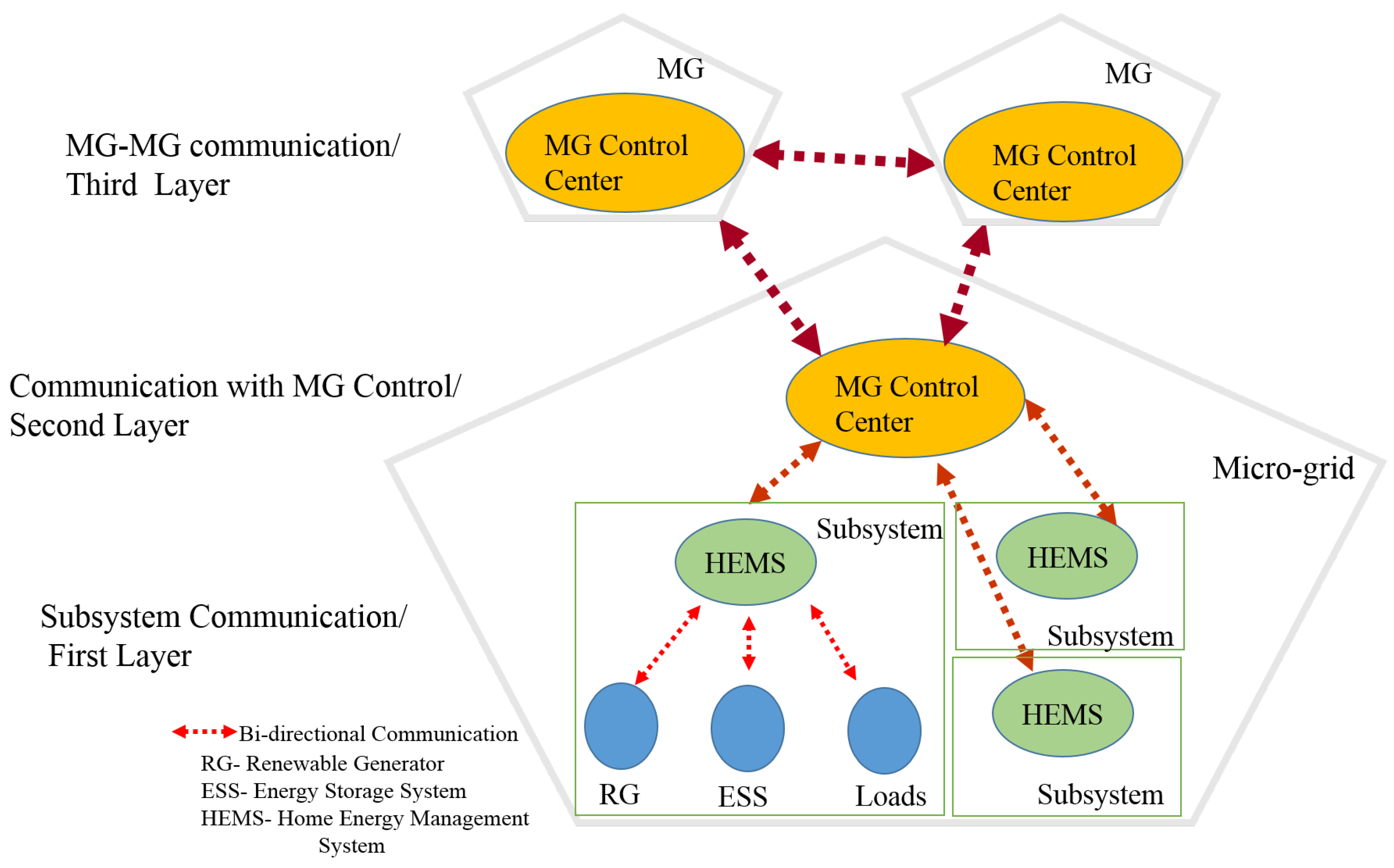
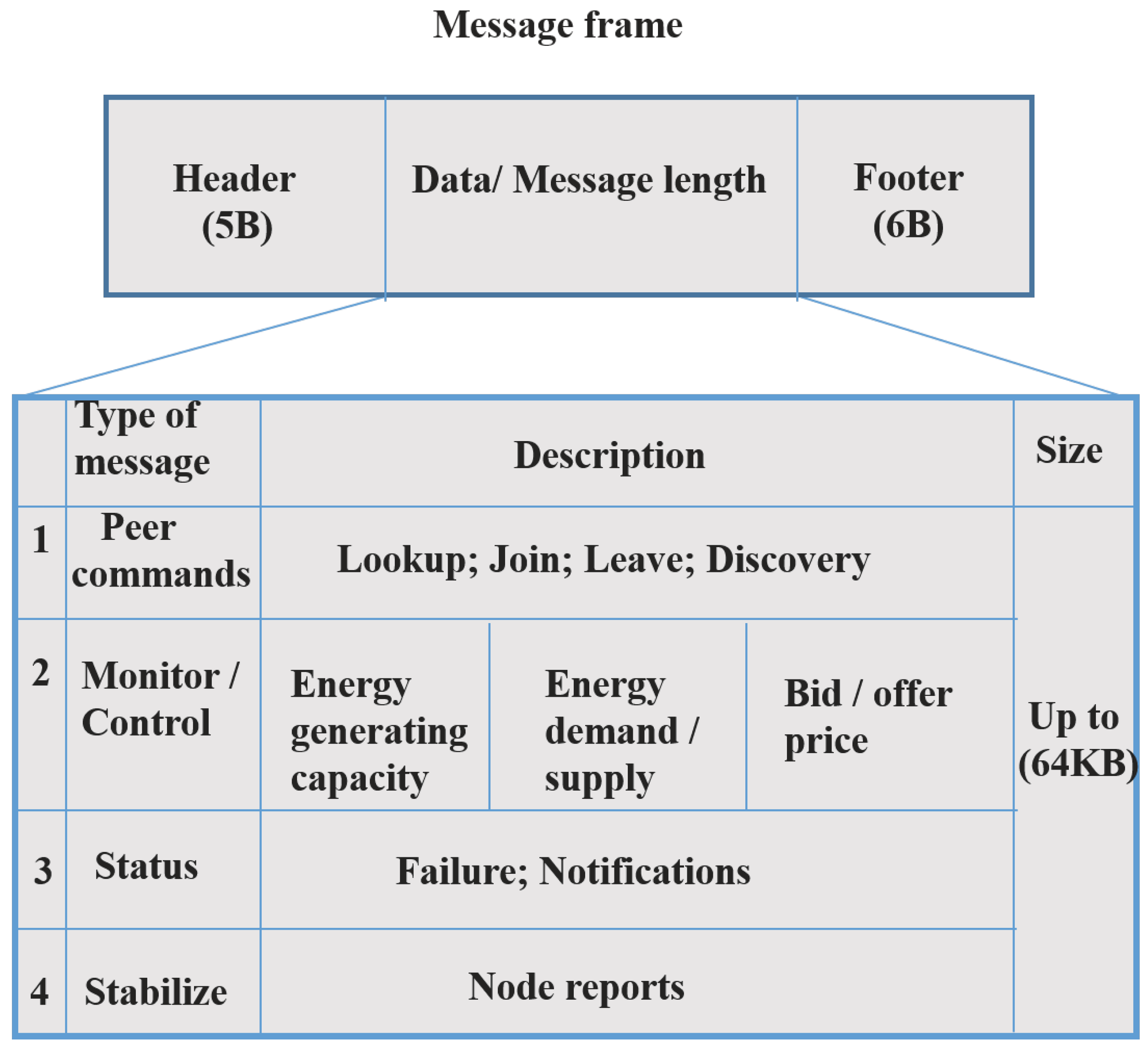
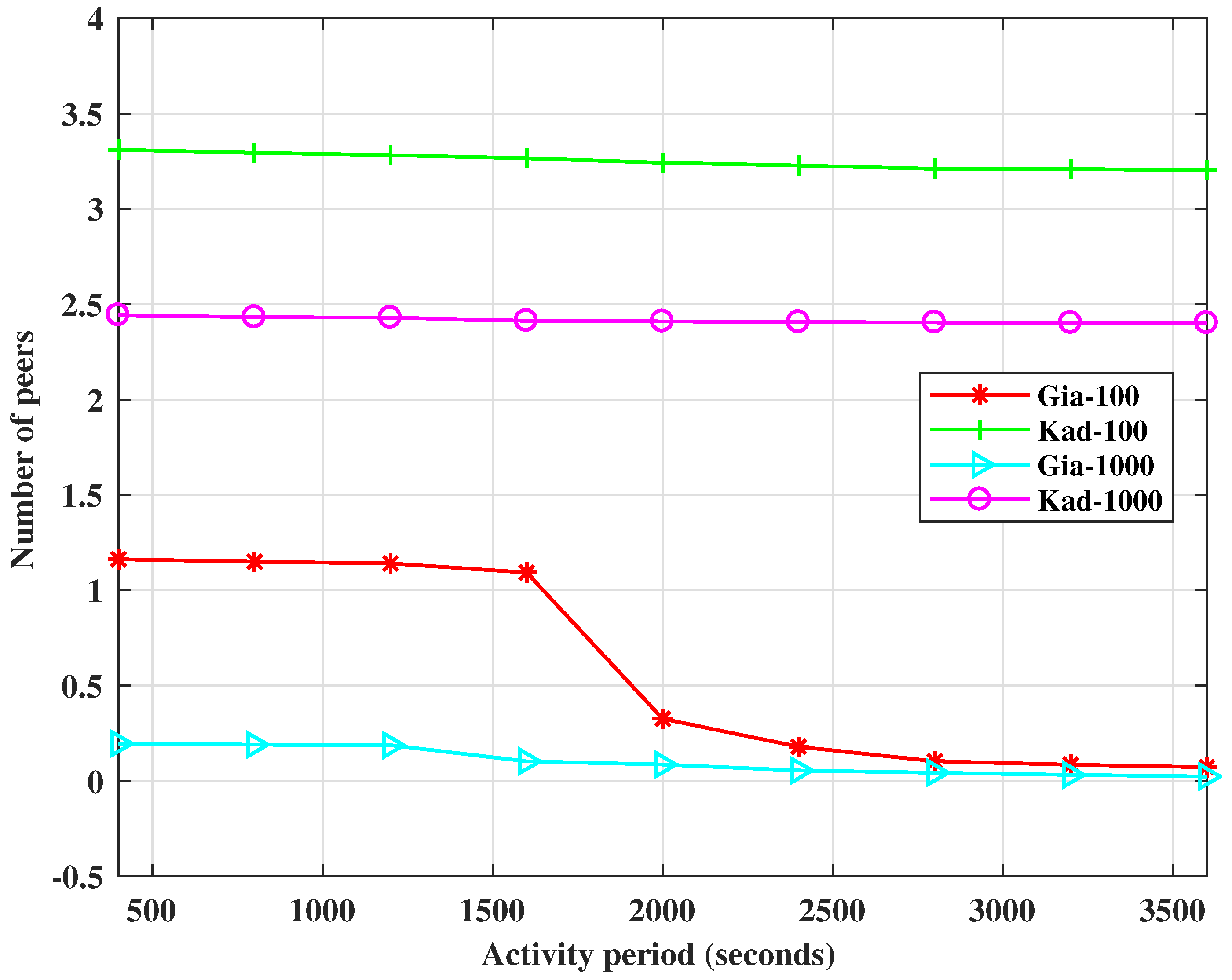
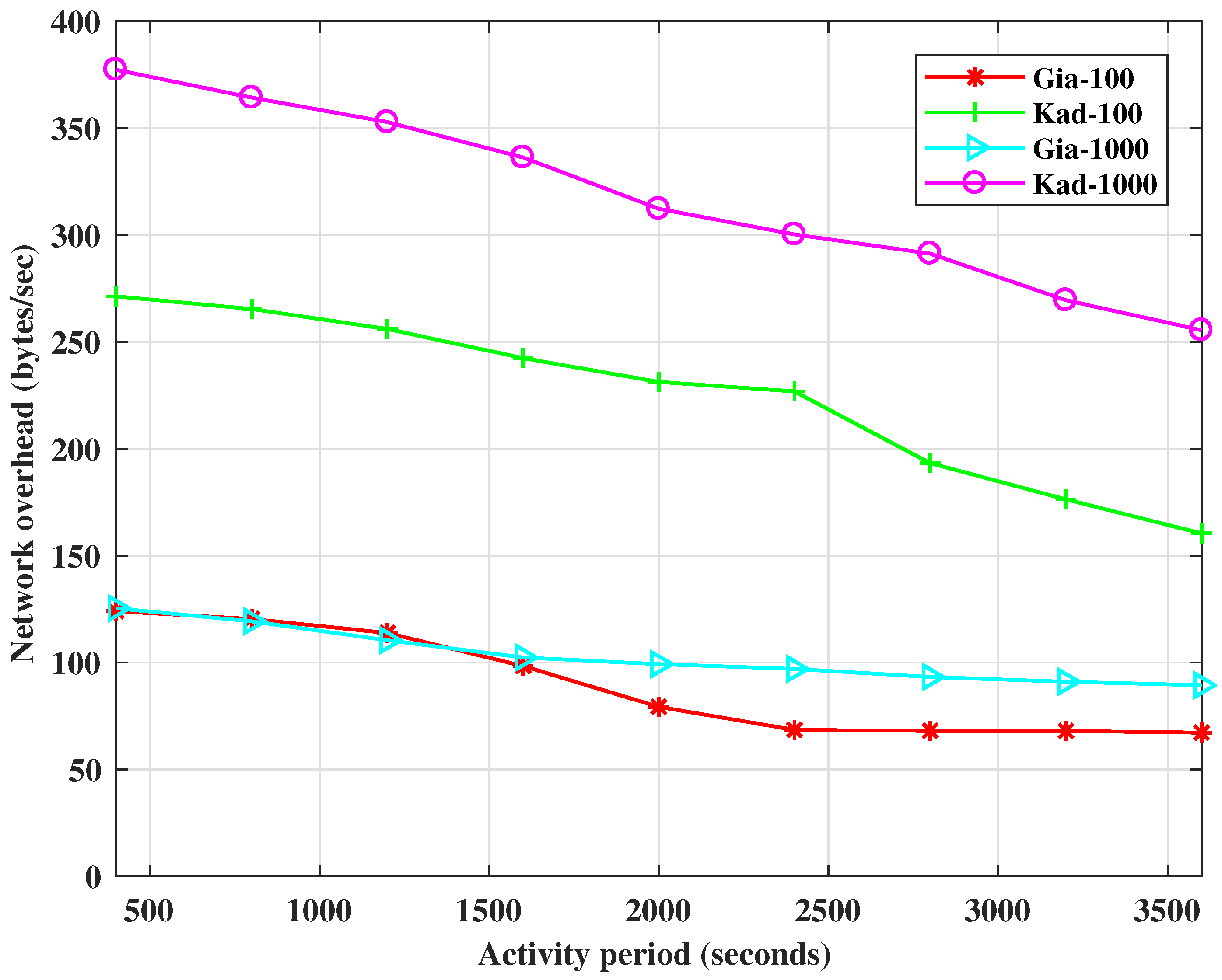
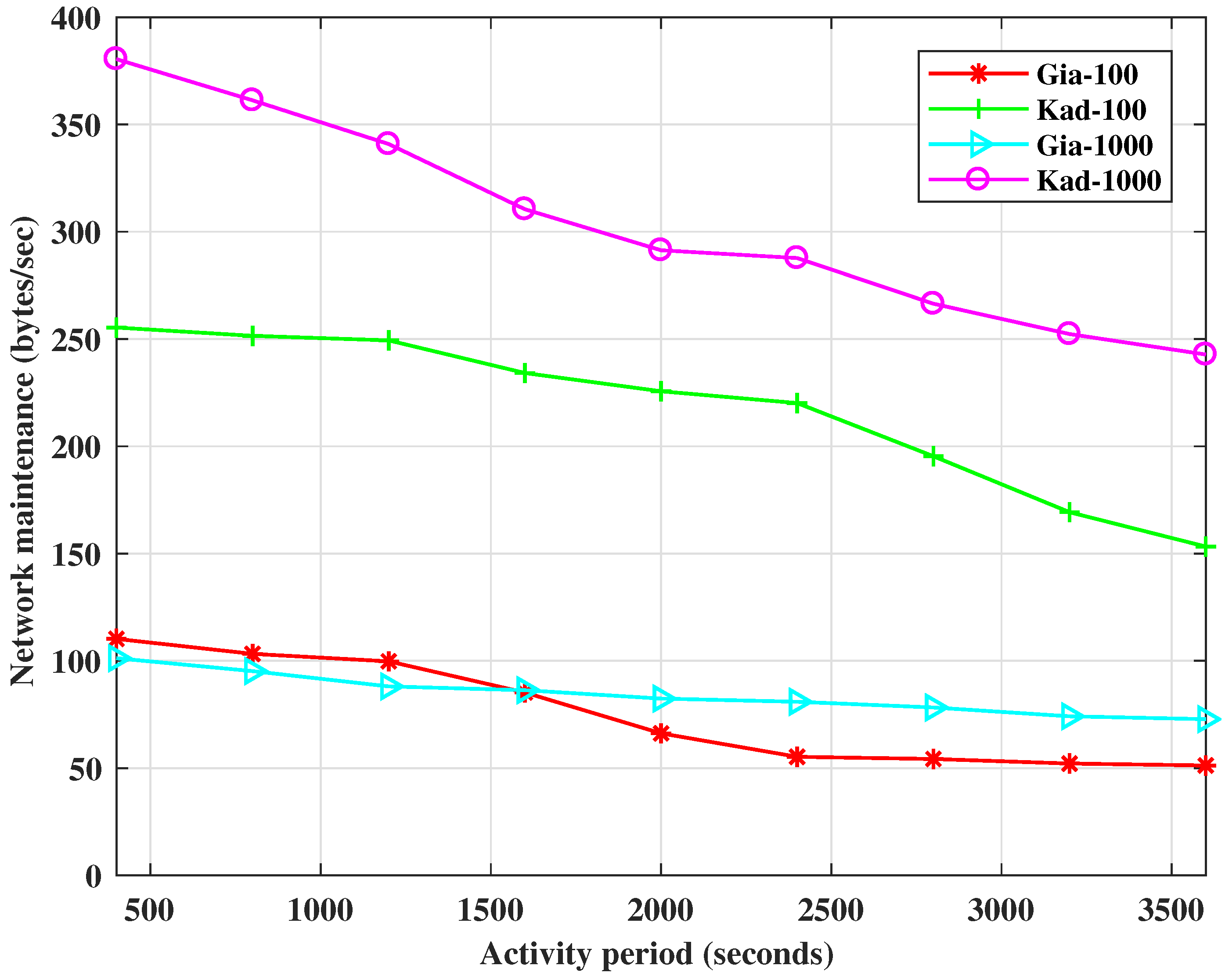
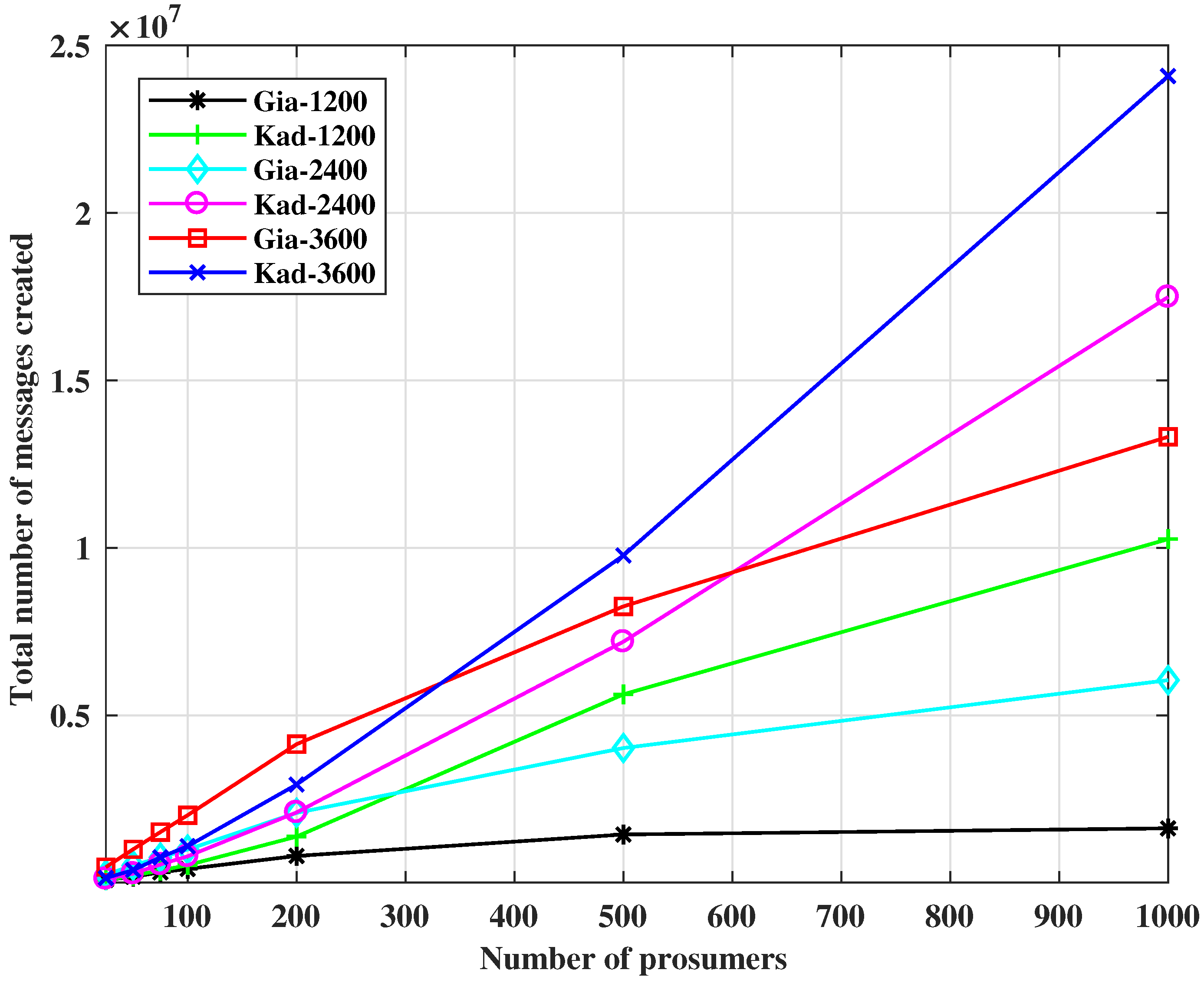
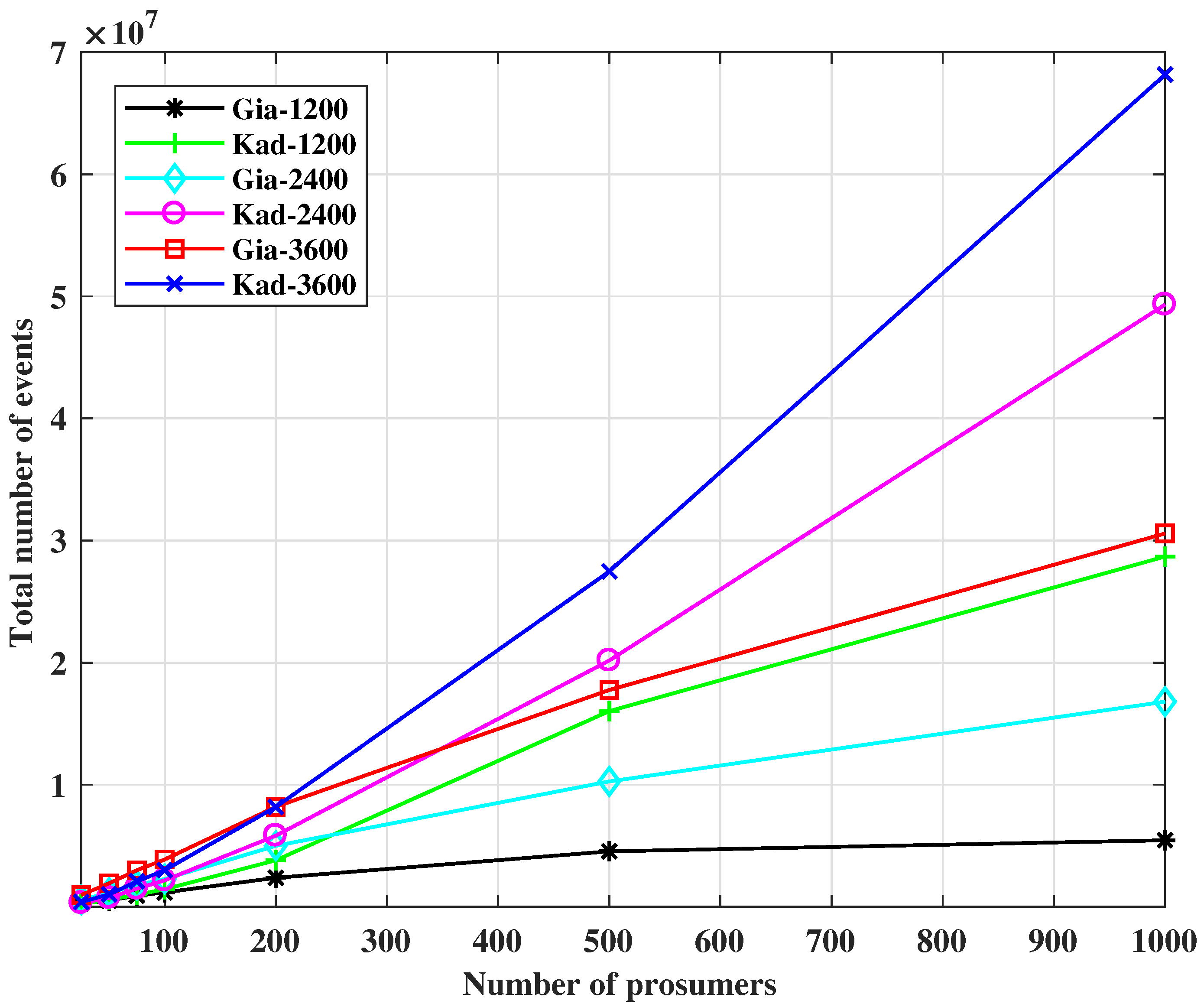
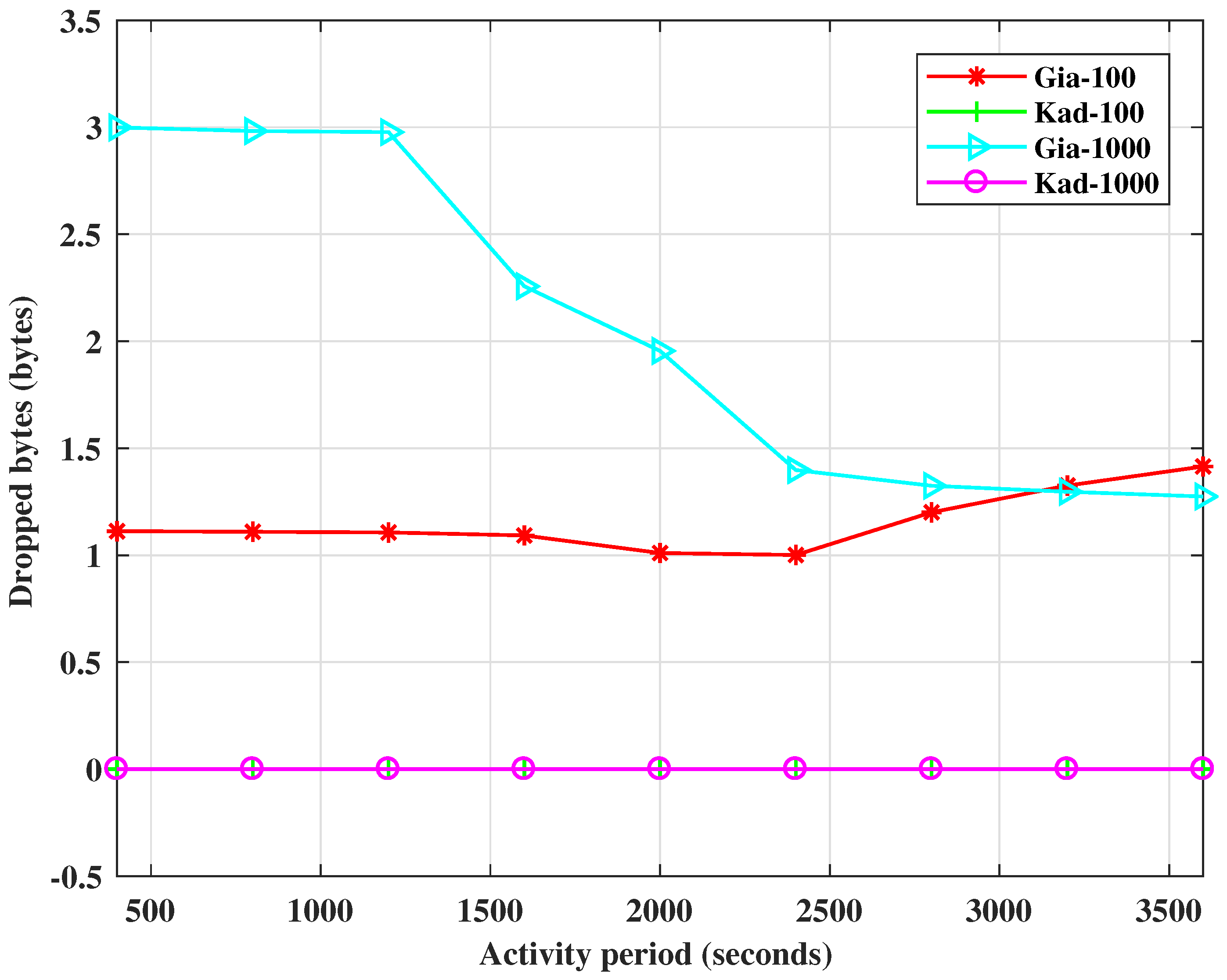
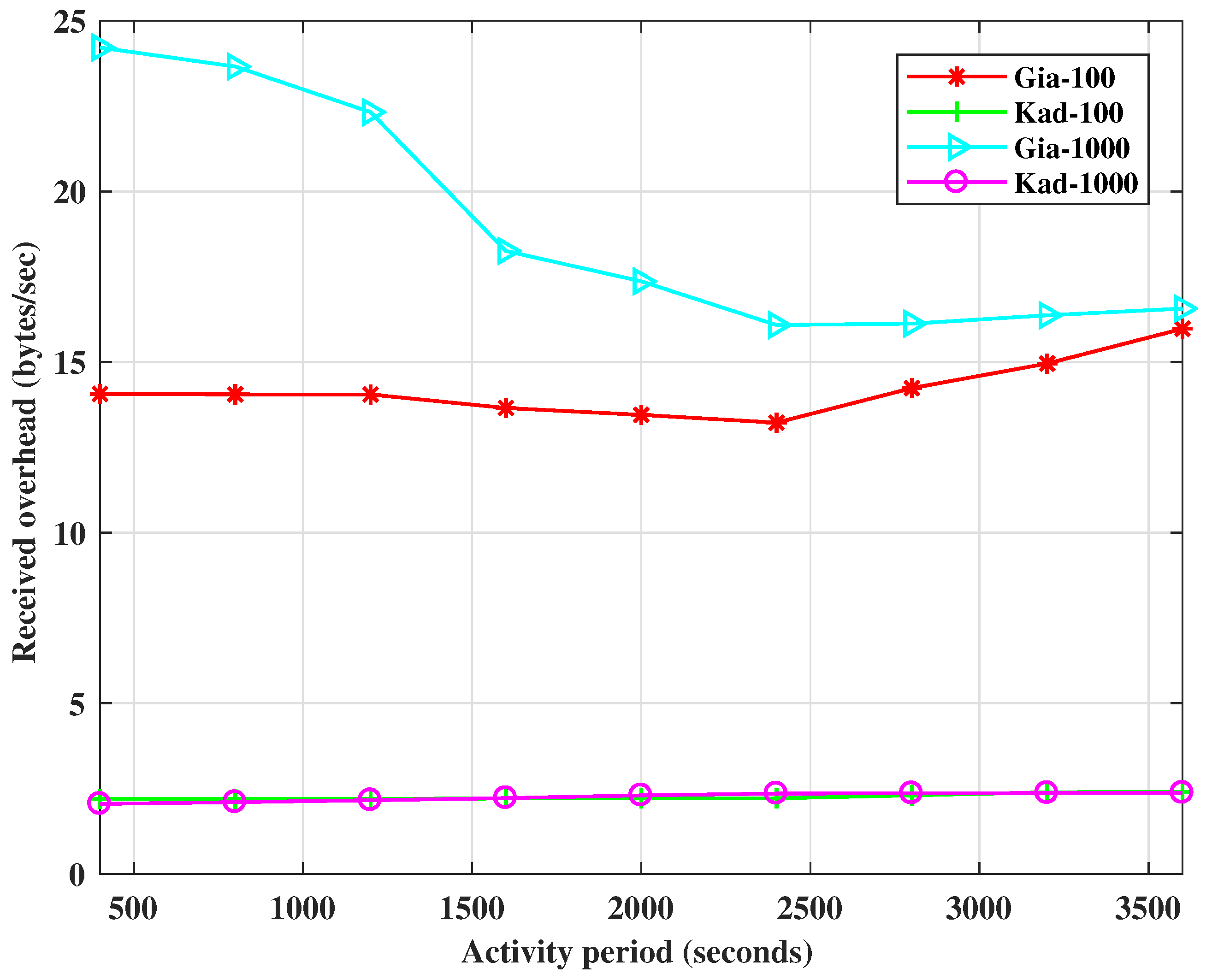
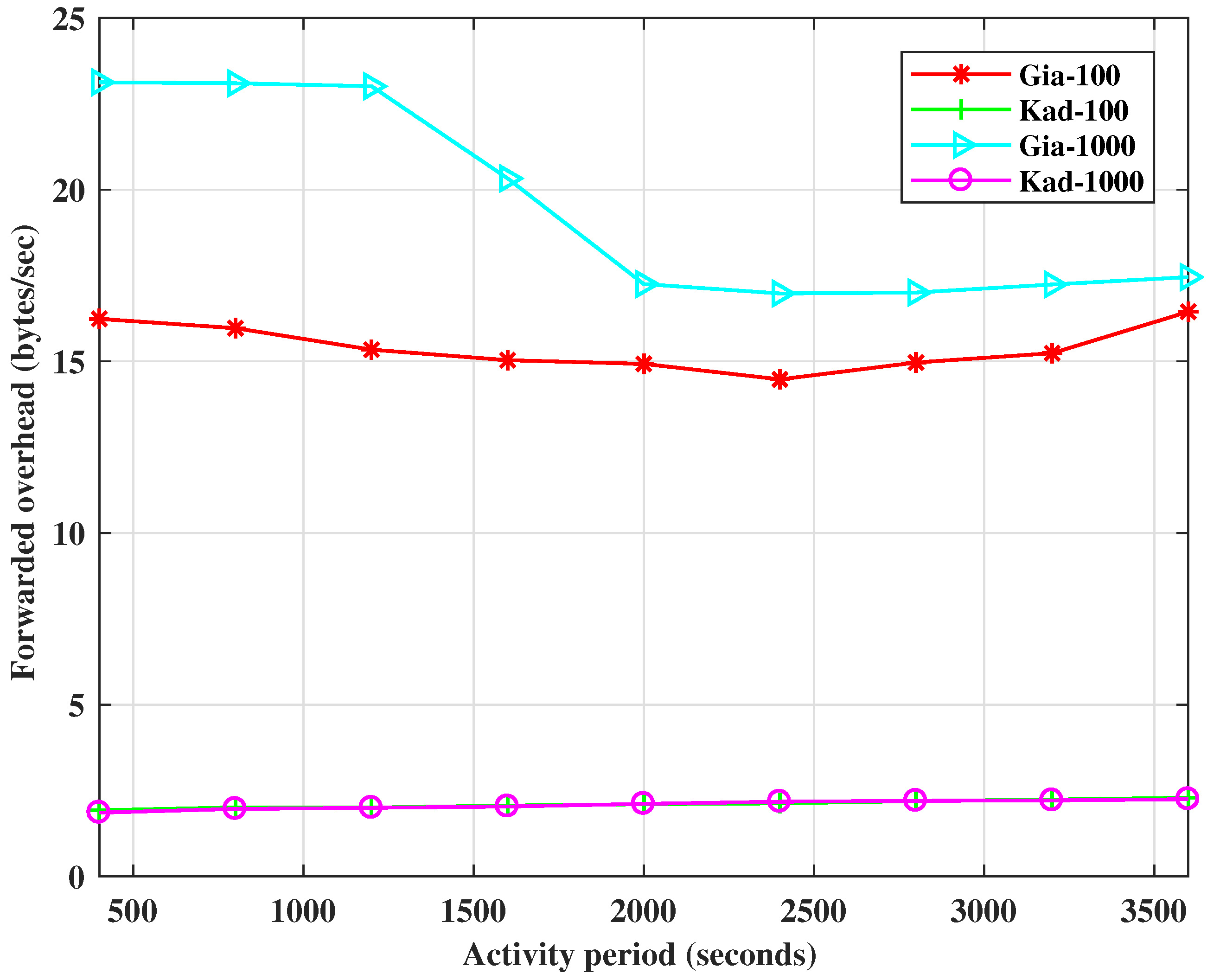
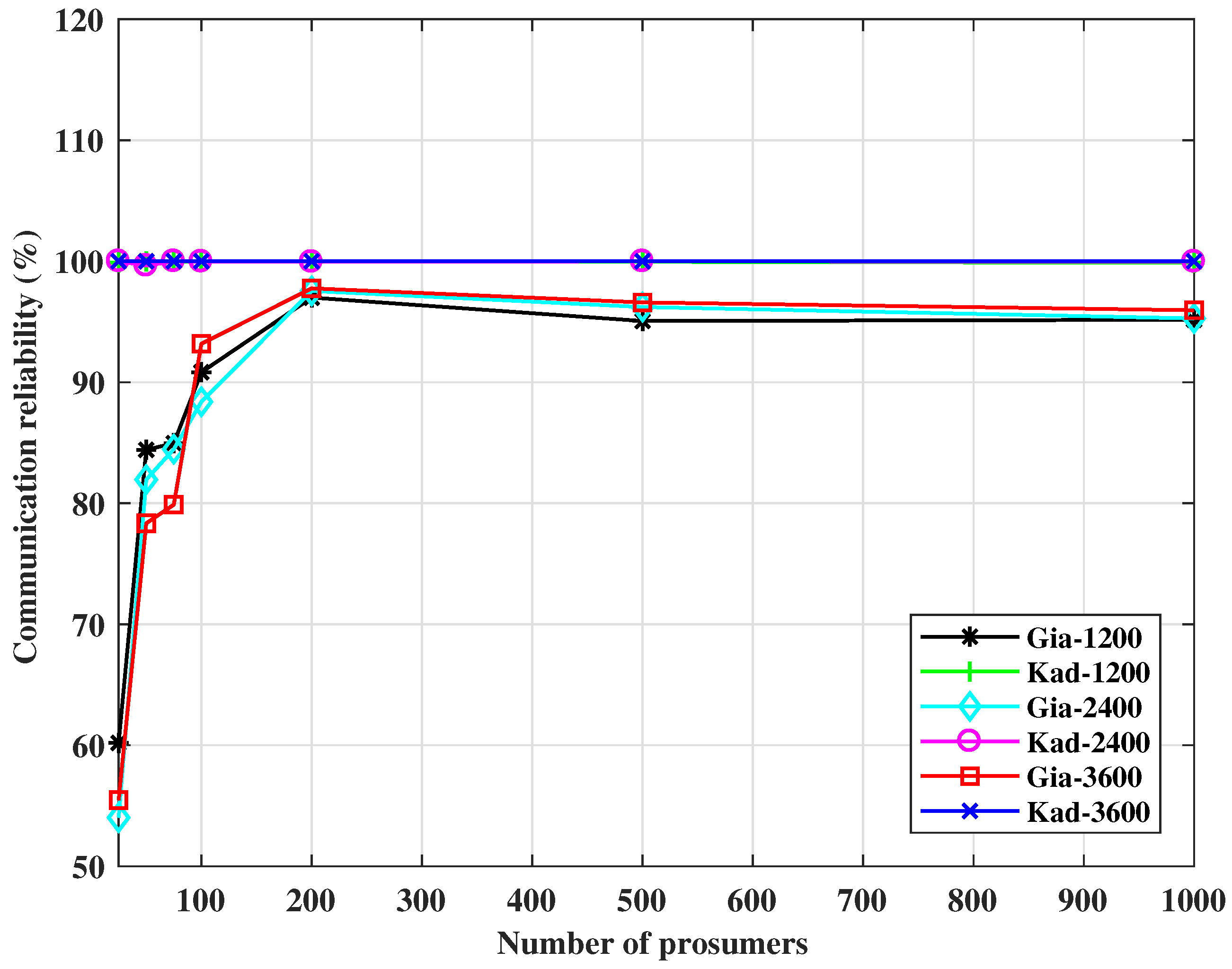
| Ref. | Structured | Unstructured | Theory-Based | Analysis-Based | Energy Network |
|---|---|---|---|---|---|
| [9,11,39] | Yes | Yes | Yes | No | Yes |
| [14] | Yes | No | Yes | Yes | No |
| [22] | Just Chord | No | Yes | Yes | Yes |
| This study | Yes | Yes | Yes | Yes | Yes |
| Application | Latency | Throughput (kbps) | Reliability (%) | Security |
|---|---|---|---|---|
| DER and Storage | <1 ms–1.5 s (MAC + Phy) 15 s (E2E application) | 9.6–56 | 99–99.9 | High |
| EV Charging | 2 s–5 m | 9.6–56 | 99–99.9 | High |
| Smart Meter | Variable | 10/m | >98 | High |
| Home Energy Mgt. | 300 ms–2 s | 9.6–56 | >98 | High |
| Demand Response | <1 m | 14–100/node | >99.5 | High |
| DCS | <5 s | 120–144 | >99.5 | High |
| Meter data Mgt. | 2 s | 56 | 99 | High |
| Asset Management | 2 s | 56 | 99 | High |
| Home/Building Auto. | seconds | 4.8–48 | >98 | High |
| Properties | Kademlia | Gia |
|---|---|---|
| Architecture | Structured | Unstructured |
| Efficient message routing | Yes | Yes |
| Message delivery | Guaranteed | Best effort |
| Single point of failure | No | No |
| Latency | High | Low |
| No of hops | 1 | |
| Scalability | Yes | Yes |
| Resilience | Yes | Yes |
| Flexibility | No | Maybe |
| Communication Protocol Stack | Parameters Used | Size |
|---|---|---|
| Application Layer | Kademlia and Gia | 100 bytes |
| Transport Layer | UDP | 8 bytes |
| Network Layer | IP | 20 bytes |
| Physical Layer | IEEE 802.11 b | Datalink (11 bytes) |
| Network Parameters | Simulation Parameters |
|---|---|
| Network size | From 25 to 1000 prosumers |
| Churn rate | Modeled as Weibull distribution |
| Activity time | ≤3600 s |
| Routing | Iterative routing |
| Lookup interval | Exponential distribution of mean 60 s |
| MG message length | 100 bytes |
© 2017 by the authors. Licensee MDPI, Basel, Switzerland. This article is an open access article distributed under the terms and conditions of the Creative Commons Attribution (CC BY) license (http://creativecommons.org/licenses/by/4.0/).
Share and Cite
Jogunola, O.; Ikpehai, A.; Anoh, K.; Adebisi, B.; Hammoudeh, M.; Gacanin, H.; Harris, G. Comparative Analysis of P2P Architectures for Energy Trading and Sharing. Energies 2018, 11, 62. https://doi.org/10.3390/en11010062
Jogunola O, Ikpehai A, Anoh K, Adebisi B, Hammoudeh M, Gacanin H, Harris G. Comparative Analysis of P2P Architectures for Energy Trading and Sharing. Energies. 2018; 11(1):62. https://doi.org/10.3390/en11010062
Chicago/Turabian StyleJogunola, Olamide, Augustine Ikpehai, Kelvin Anoh, Bamidele Adebisi, Mohammad Hammoudeh, Haris Gacanin, and Georgina Harris. 2018. "Comparative Analysis of P2P Architectures for Energy Trading and Sharing" Energies 11, no. 1: 62. https://doi.org/10.3390/en11010062






